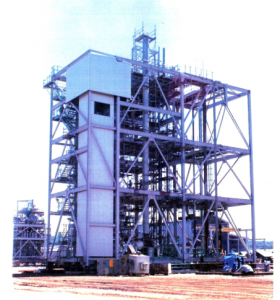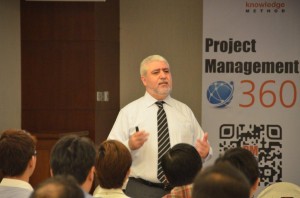This article is the third of a series of articles specific to case studies from the author own projects’ experience. We have recently presented these case studies as a workshop; part of a Project Management Conference (PM360) in Singapore that was organized by Knowledge Method, sponsored by RMC Project Management, and supported by SUKAD and two other partners.
Project Management Case Study 3
 Project Characteristics
Project Characteristics
- Mega Project: approved budget was about (~) $700 million US (early 1990’s).
- This mega project had two main sub-projects
- One sub-project was modifications to an existing refinery (~$100 million), and
- The second sub-project (~$600 million) was new facilities (grass roots/green field)
- Project was on an Island, in a country where there were limited labor and technicians.
The Project Owner
- The Project Owner was a joint venture consisting of three companies:
- 50% (N. America),
- 40% (N. America),
- 10% (Asia)
- The 10% company was a joint venture between the 40% company and a government of an Asian country.
The Service Providers
- Project Owner awarded a global contractor (main contractor) an Engineering, Procurement, and Construction (EPC) contract
- Contract was reimbursable (cost plus), incentive contract
- Main contractor was ultimately responsible for engineering, procurement, and construction management (UK); construction was to be awarded to a construction general contractor
- Construction general contractor, ended up being a joint venture between three companies (Europeans – mostly Germans)
- Construction labor came from Asian countries, senior construction staff were mostly European and Asian
Project Management
 The Project Owner was responsible for the overall management of the project (program)
The Project Owner was responsible for the overall management of the project (program)- Most project management team members came from the main partner but with a few resources from the other partners
- The owner project management team was split between Europe (UK) and S.E. Asia
- The members of the owner’s project management team came mostly from North America but also had European and Asian members
- Because of the cost plus – incentive contract, the project owner delegated some of the project management activities to the main contractor
Nature of the Contract (Challenge)
- Cost plus – incentive; means:
- Main contractor will be reimbursed for all actual costs
- Its only profit is the incentive amount that they will have to earn
- Incentive was in three parts
- Safety
- Time – schedule
- Cost …
- The first two were mostly under the control of the contractor. Cost was the challenge since the budget was the project owner budget
- Contractor cost risk
- The opportunity: for every dollar contractor save the owner, a percent of savings increased the contractor profit,
- The threat: with over expenditures, contractor profit reduces; possibly going to zero on the cost incentive,
- Owner protected the contractor from owner driver project changes and currency fluctuations.
Dealing with the Challenge (Stakeholders’ Involvement)
- Owner project control team was limited to 2 resources; mostly one,
- Main contractor control team had numerous resources,
- As a result, we unofficially integrated the project control team as the first step,
- Next step, we identified the main control accounts,
- Each control account had an owner (resident engineer, contract manager, etc.),
- Project control identified the budget for each control accounts,
- Analyzed the accounts for possible cost savings (from project control perspectives),
- Met with each control account owner, and shared with them project control perspective,
- Invited the accounts’ owners to be proactively involved in the control aspects (they usually focus on implementation) and work with us on identifying more opportunities,
- Once we agreed on the approach, project control provided accounts manager with management reports, in addition to weekly, or monthly, meetings to discuss status and opportunities.
Results
- Mixed results since not all control accounts owners worked with us closely,
- For most of the cases, the stakeholders involvement worked well with building relations, which led to cost savings,
- Key to success was: cost effectiveness reduced the owner costs, increased contractor’s profit, led to bonuses for contractor’s managers, plus good performance reviews …, in other words, it was a win-win-win situation (owner-contractor-people).
Project’s Results
- Contractor earned the maximum on safety and schedule incentives and close to the maximum on cost performance
- Of course, the above case was not the only reason for this success; other practices played a significant role; primarily the innovative planning and implementation techniques
 SUKAD offers learning programs for capital investment (intensive) projects such as the one discussed in this case study. These learning programs include PM Case Studies, Managing Project Success, Project Management for the Capital Intensive Projects, Project Management for Oil & Gas, Project Change Management for Capital Projects, Project Control for Managers, Project Control Workshop … Among many others.
SUKAD offers learning programs for capital investment (intensive) projects such as the one discussed in this case study. These learning programs include PM Case Studies, Managing Project Success, Project Management for the Capital Intensive Projects, Project Management for Oil & Gas, Project Change Management for Capital Projects, Project Control for Managers, Project Control Workshop … Among many others.
 We also provide organizational and consultancy solutions for these types of projects. These solutions include implementing project management office (PMO), project support office, project reviews, project control services, clients’ representative, and even full outsourcing solutions for small and medium size enterprises.
We also provide organizational and consultancy solutions for these types of projects. These solutions include implementing project management office (PMO), project support office, project reviews, project control services, clients’ representative, and even full outsourcing solutions for small and medium size enterprises.
